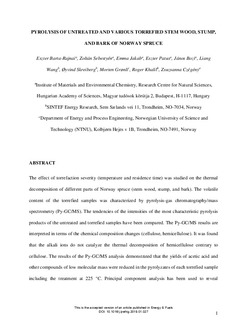| dc.contributor.author | Barta-Rajnai, Eszter | |
| dc.contributor.author | Sebestyén, Zoltán | |
| dc.contributor.author | Jakab, Emma | |
| dc.contributor.author | Patus, Eszter | |
| dc.contributor.author | Bozi, Janos | |
| dc.contributor.author | Wang, Liang | |
| dc.contributor.author | Skreiberg, Øyvind | |
| dc.contributor.author | Grønli, Morten | |
| dc.contributor.author | Khalil, Roger Antoine | |
| dc.contributor.author | Czégény, Zsuzsanna | |
| dc.date.accessioned | 2019-11-04T08:11:22Z | |
| dc.date.available | 2019-11-04T08:11:22Z | |
| dc.date.created | 2019-03-12T04:39:40Z | |
| dc.date.issued | 2019 | |
| dc.identifier.citation | Energy & Fuels. 2019, 33 (4), 3210-3220. | nb_NO |
| dc.identifier.issn | 0887-0624 | |
| dc.identifier.uri | http://hdl.handle.net/11250/2626254 | |
| dc.description.abstract | The effect of torrefaction severity (temperature and residence time) was studied on the thermal decomposition of different parts of Norway spruce (stem wood, stump, and bark). The volatile content of the torrefied samples was characterized by pyrolysis–gas chromatography/mass spectrometry (Py–GC/MS). The tendencies of the intensities of the most characteristic pyrolysis products of the untreated and torrefied samples have been compared. The Py–GC/MS results are interpreted in terms of the chemical composition changes (cellulose and hemicellulose). It was found that the alkali ions do not catalyze the thermal decomposition of hemicellulose contrary to cellulose. The results of the Py–GC/MS analysis demonstrated that the yields of acetic acid and other compounds of low molecular mass were reduced in the pyrolyzates of each torrefied sample, including the treatment at 225 °C. Principal component analysis has been used to reveal correlations between the torrefaction temperature, residence time, and product distribution of the samples. The torrefied stem wood and stump behaved similarly during torrefaction; therefore, they can be used together in thermochemical conversion applications. However, the torrefaction of bark requires about a 25 °C lower torrefaction temperature than stem wood and stump. | nb_NO |
| dc.description.abstract | Pyrolysis of Untreated and Various Torrefied Stem Wood, Stump, and Bark of Norway Spruce | nb_NO |
| dc.language.iso | eng | nb_NO |
| dc.publisher | American Chemical Society | nb_NO |
| dc.title | Pyrolysis of Untreated and Various Torrefied Stem Wood, Stump, and Bark of Norway Spruce | nb_NO |
| dc.type | Journal article | nb_NO |
| dc.type | Peer reviewed | nb_NO |
| dc.description.version | acceptedVersion | nb_NO |
| dc.source.pagenumber | 3210-3220 | nb_NO |
| dc.source.volume | 33 | nb_NO |
| dc.source.journal | Energy & Fuels | nb_NO |
| dc.source.issue | 4 | nb_NO |
| dc.identifier.doi | 10.1021/acs.energyfuels.8b04130 | |
| dc.identifier.cristin | 1683928 | |
| dc.relation.project | Norges forskningsråd: 228726 | nb_NO |
| dc.relation.project | Norges forskningsråd: 281113 | nb_NO |
| dc.relation.project | Norges forskningsråd: 244069 | nb_NO |
| dc.description.localcode | This document is the Accepted Manuscript version of a Published Work that appeared in final form in Energy & Fuels, copyright © American Chemical Society after peer review and technical editing by the publisher. To access the final edited and published work see https://doi.org/10.1021/acs.energyfuels.8b04130 | nb_NO |
| cristin.unitcode | 194,64,25,0 | |
| cristin.unitname | Institutt for energi- og prosessteknikk | |
| cristin.ispublished | true | |
| cristin.fulltext | postprint | |
| cristin.qualitycode | 2 | |
